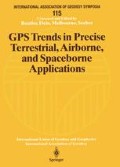Abstract
An observational equation of the GPS carrier phase contains the pair station — satellite specific and epoch independent bias γ s r = ψs(t 0)−ψ r (t 0) +N s r , in which N s r is an integer ambiguity and ψ (t 0), ψr(t 0) are transmitter and receiver initial phases. Through sequential processing of phases we update in each epoch, among other unknowns, the γ s r estimates, provided specific minimal configurations of satellites, stations and already processed epochs are satisfied. All second differences of the phases, e.g. with respect to a given reference satellite and reference receiver, ∇Δγ s r =∇ΔN s r , should be then integers on each L1 and L2 band. These conditions can be solved for all N s r ’s (thus implying new γ s r -values) about current estimates of the γ s r ’s as soon as the integer values are found by means of a proper search procedure.
Cycle slips come into view as outliers of observations produced by rapid changes of particular γ s r values. In that case a new observation sequence is created, for which new γ-parameters are estimated, and then consequently constrained for ambiguities.
Access this chapter
Tax calculation will be finalised at checkout
Purchases are for personal use only
Preview
Unable to display preview. Download preview PDF.
References
Gaiovitch I, Pachelski W (1994): Systematic Effects in GPS Positioning, Artificial Satellites, Vol. 29, No. 3.
de Jonge P, and Tiberius Ch (1995): Integer Ambiguity Estimation with the LAMBDA-Method. IUGG XXI Gen. Ass., Boulder, Colorado, USA.
Landau H (1988): Zur Nutzung des Global Positioning Systems in Geodäsie und Geodynamik: Modellbildung, Software-Entwiklung und Analyse. Schriftenreihe Univ. der Bundeswehr München, Neubiberg, Heft 36.
Lindlohr W (1988): Dynamische Analyse geodätischer Netze auf der Basis von GPSPhasenbeobachtungen. DGK, Reihe C, Heft Nr. 346, München.
Lindlohr W and Wells D (1985): GPS design using undifferenced carrier beat phase observations. Manuscripta Geodaetica, 10.
Pachelski W (1980): On the Decomposition in Least Squares (with Examples of its Application in Satellite Geodesy). DGK, Reihe A, Heft Nr. 91, München.
Pachelski W (1992a): PHANTASY: The Program for the Sequential Adjustment of Undifferenced GPS Phases. Proc. 2nd Int. Workshop on High Precision Navigation, Stuttgart and Freudenstadt, November, 1991, Ferd. Duemmlers Verlag, Bonn.
Pachelski W (1992b): Undifferenced Processing of GPS Phases. 3rd Geodetic Meeting Italia — Polonia, Trieste, Italy.
Pachelski W (1992c): Sequential Adjustment of Undifferenced GPS Phases. Proc. Intern. Workshop on Global Positioning Systems in Geosciences, Tech. Univ. of Crete, Chania, Greece, 8–10 June 1992.
Teunissen PJG (1993): Least-Squares Estimation of the Integer GPS Ambiguities. Invited Lecture, Sec. IV IAG General Meeting, Beijing, China.
Teunissen PJG (1994): On the GPS double difference ambiguities and their partial search spaces. III Hotine Marussi Symposium on Mathematical Geodesy, L’Aquila, Italy.
Teunissen PJG (1995): The Geometry of the L1/L2 Ambiguity Search Space with and without Ionosphere. IUGG XXI Gen. Ass., Boulder, Colorado, USA.
Author information
Authors and Affiliations
Editor information
Editors and Affiliations
Rights and permissions
Copyright information
© 1996 Springer-Verlag Berlin Heidelberg
About this paper
Cite this paper
Pachelski, W. (1996). GPS Phases: Single Epoch Ambiguity and Slip Resolution. In: Beutler, G., Melbourne, W.G., Hein, G.W., Seeber, G. (eds) GPS Trends in Precise Terrestrial, Airborne, and Spaceborne Applications. International Association of Geodesy Symposia, vol 115. Springer, Berlin, Heidelberg. https://doi.org/10.1007/978-3-642-80133-4_48
Download citation
DOI: https://doi.org/10.1007/978-3-642-80133-4_48
Publisher Name: Springer, Berlin, Heidelberg
Print ISBN: 978-3-540-60872-1
Online ISBN: 978-3-642-80133-4
eBook Packages: Springer Book Archive

